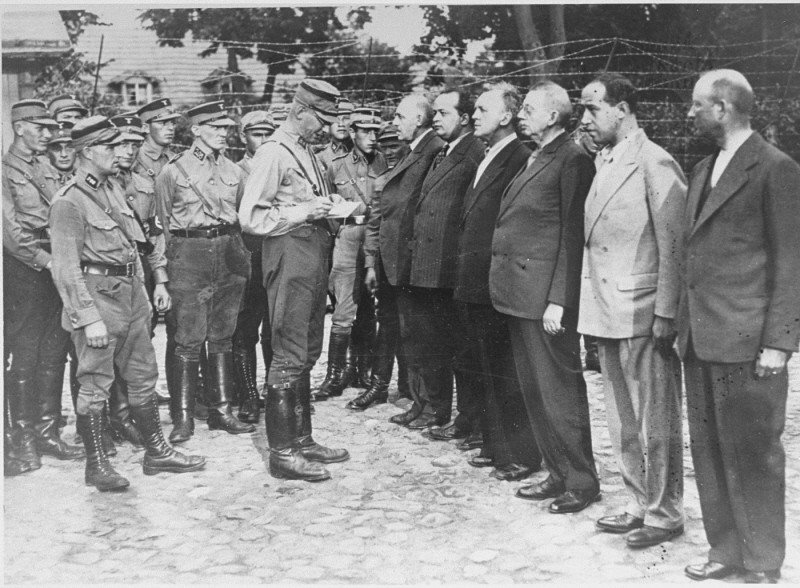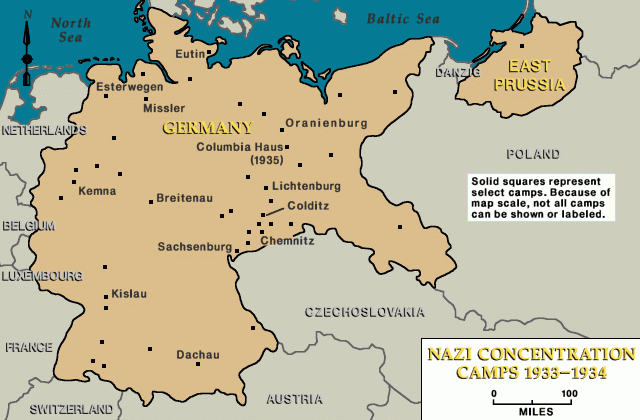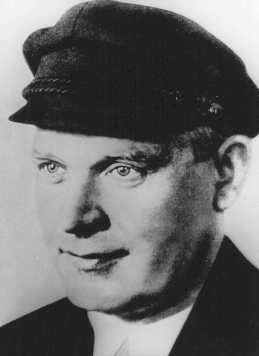
Political Prisoners
The Nazis demanded that Germans accept the premises of the Nazi worldview and live their lives accordingly. They tolerated no criticism, dissent, or nonconformity. Hitler's political opponents were the first victims of systematic Nazi persecution.
Key Facts
-
1
Various German authorities established the first concentration camps in Germany soon after Adolf Hitler's appointment as chancellor in January 1933.
-
2
By the end of 1934, the German authorities established a centrally organized concentration camp system under the exclusive jurisdiction of the SS.
-
3
Nazi persecution of political opponents exacted a terrible price in human suffering.
Nazi Persecution of Political Opponents
After World War I (1914-1918), nationalist, right-wing political movements in Germany and Austria tended to see the nation in collective terms as a Volksgemeinschaft or national community. Racist nationalists on the extreme right of the political spectrum saw this collective as a voelkische Gemeinschaft, by which they meant a racial group that they considered superior. Adolf Hitler and the Nazis, among other radical right-wing groups, adopted this view of the German nation.
Unlike Western liberals or nationalists, the Nazis did not find value in individuality. For the Nazis, individualism was an egotistic, culture-corroding, Jewish value that would tear apart the fabric of the communal nation. The Nazis insisted that the individual had value only in his or her membership in the collective racial community.
A key Nazi criticism of Weimar democracy in particular and liberal democracy in general was that it emphasized the individual. This emphasis in turn misled or duped members of a race into relinquishing their “natural” race consciousness. In their campaign to destroy any political or spiritual loyalty other than to the race-nation, the Nazis hoped to “reeducate” the German people to become “conscious” of something that already existed: their racial heritage and the ensuing obligations to maintain the survival of the race.
The Nazis persecuted non-Jewish German opponents, both real and perceived. Whether they were political (Communists, Social Democrats, Democrats), spiritual (Jehovah's Witnesses), or “social” (Homosexuals) opponents—Nazi racial theory held that they were valuable members of the race. These non-Jewish German opponents needed to understand their racial value and then follow their restored “natural instinct” to do the right thing: accept and internalize the Nazi vision of the world.
Although in practice the Nazis moved harshly, and often with lethal outcome, against activists who “impeded” the realization of race consciousness, they expected, in accordance with their racist view, that the rank and file—perhaps after a time in a concentration camp—would “see the light” and fall in with the collective.
The Nazis demanded that Germans accept the premises of the Nazi worldview and live their lives accordingly. They tolerated no criticism, dissent, or nonconformity. Following his appointment as chancellor by President Paul von Hindenburg on January 30, 1933, Adolf Hitler began laying the foundations for Nazi control of the state. Guided by racist and totalitarian principles, the Nazis eliminated individual freedoms and pronounced the creation of the national community, in whose name they seized every opportunity to turn Germany into a unified racial collective
Hitler also moved carefully to organize the police power necessary to enforce his long-term policies of "racial" purification and European conquest both inside and outside the legal framework of the German constitution. Given the Nazis' public aims of destroying the “Marxist” threat in Germany and tearing up the Versailles Treaty, aims that were shared by a majority of the German population, Hitler's political opponents were the first victims of systematic Nazi persecution.
Political Prisoners and the Establishment of Nazi Concentration Camps
The term "concentration camp" refers to a camp in which people are detained or confined, usually under harsh conditions and without regard to legal norms of arrest and imprisonment. The term was first used in reference to detention camps established by British authorities to detain suspected rebels and their families during the Boer war in South Africa at the beginning of the 20th century.
Various German authorities established the first concentration camps in Germany soon after Adolf Hitler's appointment as chancellor in January 1933. The SS, SA (Storm Troopers), the police and civilian authorities set up hundreds of makeshift “camps” in empty warehouses, factories, and other locations across Germany. The camps served as “temporary” detention centers for political opponents who were incarcerated without trial and under conditions of great cruelty.

Camps were located in Oranienburg, north of Berlin; Esterwegen, near Hamburg; Dachau, northwest of Munich; and Lichtenburg, in Saxony. By the end of July 1933, almost 27,000 people—virtually all of them political prisoners—were incarcerated in these camps.
By the end of 1934, the German authorities disbanded most of these early concentration camps. In their place and under the exclusive jurisdiction of the SS, they established a centrally organized concentration camp system. The first SS concentration camp had been established on March 20, 1933 at Dachau, in an abandoned World War I munitions factory. Located near Munich in southwestern Germany, Dachau served as the “model” for a vast system of SS camps. By 1939, six large concentration camps had been established. Besides Dachau, they were Sachsenhausen (1936), Buchenwald (1937), Flossenbürg (1938), Mauthausen (1938), and to house women prisoners, Ravensbrück (1939).

Nazi persecution of political opponents exacted a terrible price in human suffering. Between 1933 and 1939, the criminal courts sentenced tens of thousands of Germans for "political crimes." If the police were confident of a conviction in court, the prisoner was turned over to the justice system for trial. If the police were unsatisfied with the outcome of criminal proceedings they would take the acquitted citizen or the citizen who was sentenced to a suspended sentence into protective detention and incarcerate him or her in a concentration camp. On the eve of World War II, concentration camps held about 25,000 inmates, most of them political prisoners.

Anti-Nazi politicians and union workers either fled Germany or faced long-term confinement in a concentration camp. Ernst Thälmann, leader of the German Communist party since 1925 and one-time candidate for the German presidency, for example, had been arrested after the fire that destroyed German parliament building in 1933. He spent more than 11 years in the camps. The SS killed him in Buchenwald concentration camp on August 18, 1944, during an air raid on a nearby factory.
After 1939, with new territorial conquests and larger groups of potential prisoners, the concentration camp system expanded rapidly both in the number of prisoners and in geographic locations. Concentration camps increasingly became sites where the SS killed targeted groups of real or perceived enemies of Nazi Germany. Those used as forced laborers were deliberately undernourished and mistreated with the intent that they be "annihilated by work." Many prisoners died of starvation, disease, mistreatment or accident while at hard labor.

